
About
Research
News-Event

About
Research
News-Event
Research
Detailed List of Research Seeds
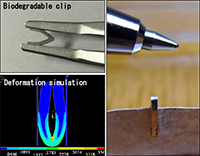
Research on biodegradable implant
Professor Toshiji Mukai
Assistant Professor Naoko Ikeo
Metallic materials are widely used in a medical setting as devices for clamping and sustaining body tissues which require treatment by accident or disease, because they maintain high strength for a long time. For example, titanium alloys have high strength, corrosion resistance and biocompatibility, thus they are applied to devices such as clips for clamping tissues, plates for bone junction and artificial hip joints. On the other hand, after body tissues are treated, artificial devices are not required. Those devices often cause CT artifacts and inflammations, therefore biodegradable devices, which are degraded in vivo with time and eliminated from the body, have received a lot of attention. Then, in this research project we focus on magnesium and zinc which are essential elements and biodegradable, and conduct a study for applying those metals to devices for clamping tissues. Specifically, we carry out optimum design of materials and configurations for devices, prototype fabrication of model devices and performance validation by collaborative experiment with medical researchers.
→Website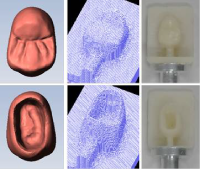
Research on tailor-maid machining of medical devices
Professor Keiichi Shirase
Associate Professor Isamu Nishida
In order to achieve tailor-maid machining of medical devices, a new method to generate automatically an instruction program for numerical controlled machine tools from a 3D CAD model of a dental artificial crown. Unlike mass-produced industrial products, singly produced medical devices requires huge amount of time and cost to generate manually an instruction program for machining. In our new method, not only calculation of tool paths for machining, but also adjustment of cutting conditions are performed to avoid tool breakage in machining operation. In the experimental machining verification performed by the generated instruction program, 80% machining time reduction can be achieved without tool breakage.
→Website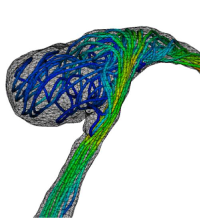
Study on Numerical Simulations of Blood Flows
Professor Akio Tomiyama
Associate Professor Kosuke Hayashi
Characteristics of blood flows in human blood vessels are being numerically investigated using CFD. The left figure shows a blood flow in a cerebral aneurysm predicted using the lattice Boltzmann method. The cerebral aneurysm model was reconstructed from TOF-MRA data. A cerebral aneurysm is a saccular dilatation forming on cerebral arteries. Rupture of a cerebral aneurysm causes swift death or poor prognosis at a high probability. Most cerebral aneurysms, therefore, are either stented or clipped to prevent rupture. If cerebral aneurysms are known to hardly rupture under the patient specific condition, such surgery burdensome for patients can be avoided. Understanding the mechanism of the aneurysm growth is therefore of great demand of neurosurgeons. This study has been carried out to develop a numerical tool for understanding the relation between the blood flow characteristics and the aneurysm growth in a collaboration with the research group of Prof. E. Kohmura and Dr. H. Kimura at the Department of Neurosurgery, Kobe University.
→Website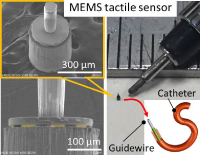
Study on a micro MEMS tactile sensor for a minimally invasive surgery
Professor Yoshitada Isono
Professor Koji Sugano
A medical catheter has widely been used as a minimally invasive medical device, for insertion of vasodilator balloons and stents into blood vessels. A guide wire attached to the tip of the catheter moves in the blood vessel in advance in order to carry the balloon and the stent to the affected part. However, the problem of damaging the blood vessel wall when inserting into a blood vessel has been reported. Although the position of the tip of the guide wire is judged from the X-ray image, the contact situation between the guide wire tip and the blood vessel has been coordinated by the feeling of the doctor hands. In order to realize highly safe minimally invasive surgery, it has strongly been needed to realize a system that can operate while detecting the force applied to the tip. Therefore, we have studied on micro 3-axis tactile sensors using MEMS (Microelectromechanical Systems) technology. This sensor, extremely tiny diameter of 0.32 mm, is fabricated from silicon (Si) using MEMS fabrication processes. The sensor is attached to the tip of the guide wire and allows us to measure the force applied to the tip. Detection of forces in 3-axis directions gives us a lot of information of contact situation between the guide wire and the blood vessel. It is expected to prevent an accident in a catheter surgery.
→Website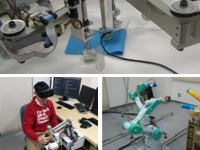
Research on Dexterous Manipulation and Teleoperation
Professor Yasuyoshi Yokokohji
Assistant Professor Hikaru Nagano
It is difficult to robotize dexterous manipulation like humans, and the robot hand comparable to human dexterity has not been realized yet. We took “origami folding” as a target task, and have been trying to understand why humans can dexterously manipulate origami, which is flexible and has unpredictable behaviors, and to realize such dexterous manipulations by a robot. On the other hand, even when a human operates the work in an extreme environment from a distance, it is not easy to work with full use of the dexterity that the operator originally has. Therefore, in order to realize a high fidelity teleoperation system with which the operator can operate the remote robot intuitively, we have been conducting basic research on the control methods for teleoperation, sensory feedback to the operator, and the human-machine interface. These studies are expected to lead to the realization of dexterous hands for medical robots and the development of remote-controlled surgical robots.
→Website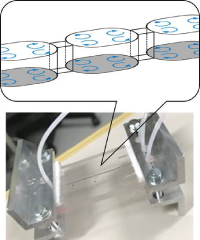
Precise analysis of fast chemical reactions using an oscillatory baffled reactor
Professor Naoto Ohmura
There exist many fast chemical reactions in the field of fine chemicals that produces pharmaceuticals. Since it is difficult to analyze the reaction rate of fast reactions using a typical batch reactor, a microreactor with a very narrow flow channel is usually used for this purpose. Mass transfer is achieved by diffusion at the two fluid interface. However, the flow is laminar regime and mixing in the radial direction of the flow channel does not occur and the residence time distribution is also broaden. It can be said that the performance of the microreactor is insufficient. An oscillatory baffled reactor is a continuous reactor having baffles (narrowed flow channel) at equal intervals in the flow channel, and a oscillatory flow, back and forth flow, is given in addition to the net flow rate. As a result, vortices generate in front and behind of the baffles, inducing rapid mixing in the radial direction while it is a laminar flow, and mixing in the axial direction can be minimized as much as possible. In other words, this OBR is a continuous reactor with very high plug-flow performance. We have already succeeded in analyzing the reaction rate of a fast reaction with a complicated reaction path using a micrometer scale oscillatory baffled reactor. In addition, since the oscillatory baffled reactor is very effective in converting batch processes into continuous processes, we are investigating the performance of the continuous crystallizer as well.
→Website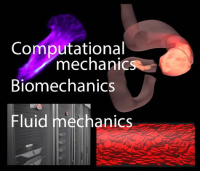
Research on computational biomechanics of physiological flows
Professor Yohsuke Imai
Assistant Professor Shunichi Ishida
Flows play important roles in physiological functions. Examples include blood flows, respiratory airflows, and gastrointestinal flows. A small change in flows may cause several types of diseases. However, it is experimentally difficult to visualize the flows in our body. We are developing computational biomechanics of physiological flows for understanding physiological functions and diseases from mechanical perspectives. Flows in our body are often very complex. For instance, blood is a suspension of red blood cells, and food bolus in the gastrointestinal system consists of gases, liquids and solids. We must analyze an integrated system, coupling fluid mechanics with solid mechanics, biochemical interaction etc. We will establish biofluid mechanics of the gastrointestinal system and computational biomechanics of malaria and metastasis using advanced techniques of computational mechanics.
→Website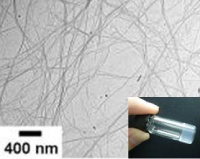
Study on novel hydrogels that work as an anticancer drug
Professor Tatsuo Maruyama
Supramolecular hydrogel, which is formed by the self-assembly of small molecular building blocks (low-molecular-weight gelators), is a new class of hydrogel discovered in the last decade that has attracted much attention owing to being thermoreversible, designable and responsive to external stimuli. We found supramolecular gelators that worked as unique candidates of anti-cancer drugs. The anti-cancer supramolecular gelators, we recently synthesized peptide-amphiphile, has a simple molecular structure that can gelate the interior of cancer cells in the presence of cancer-related enzyme.
→Website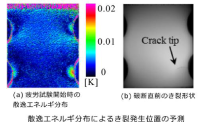
Research on Fatigue strength evaluation for metallic biomaterials
Associate Professor Daiki Shiozawa
Metallic biomaterials are used in medical devices such as artificial joints and bone plates. Metallic materials subjected to small cyclic loads break after prolonged use (called as fatigue). In structures such as airplanes and railways, the strength against fatigue of materials is evaluated to prevent accidents caused by fatigue. The fatigue strength In vivo is reduced compared to the atmospheric environment due to the influence of chemical and biochemical factors. In order to use metallic biomaterials safely for a long period of time, it is necessary to evaluate the fatigue strength of the materials in the vivo environment. In this study, research on the evaluation of fatigue crack growth characteristics and the elucidation of a mechanism of the crack initiation for metallic biomaterials are conducted using infrared thermography and synchrotron radiation CT imaging.
→Website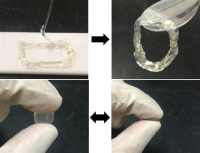
Research on Biocompatible Soft Materials
Associate Professor Tooru Ooya
Biocompatible materials are increasingly becoming more important to satisfy the diversifying needs of medical practices. Precious design of the biomaterials has crucial role to increase its ripple effect on medical applications: The materials morphology includes solutions, gels, crystalline / amorphous solids etc. For example, water-soluble dissolving agents that dissolves poorly water-soluble drugs, nanoparticles bearing high targeting ability toward tumor tissues, a polymer solution having in-situ gelling ability in view of post-operative tissue adhesion prevention, hydrogels that are excellent in mechanical properties and excellent in the ability to induce differentiation from cells to tissues are ideal for designing materials according to the requirements of the medical field. Therefore, from the synthesis of biocompatible materials to the functional evaluation in view of the spread to these medical sites, we are pursuing the significance as a biomaterial. Specifically, we are promoting the development of self-healing gel by using natural polysaccharides, stabilization and the controlled release of physiologically active molecules utilizing phase separation phenomena, nanoparticles / solution having supramolecular structure, and biodegradable materials.
→Website